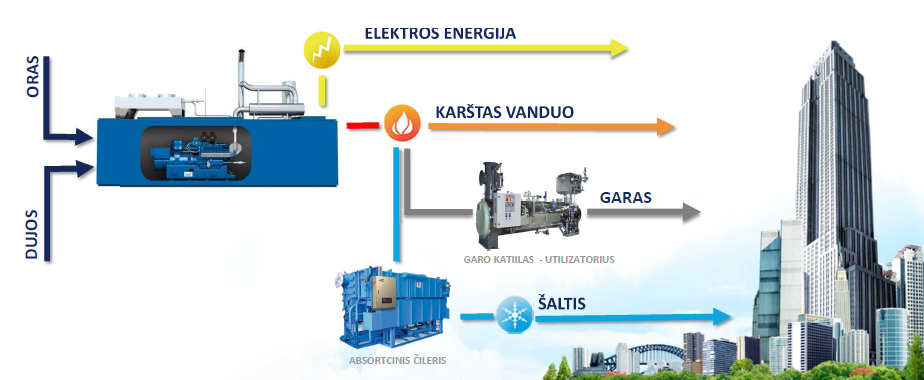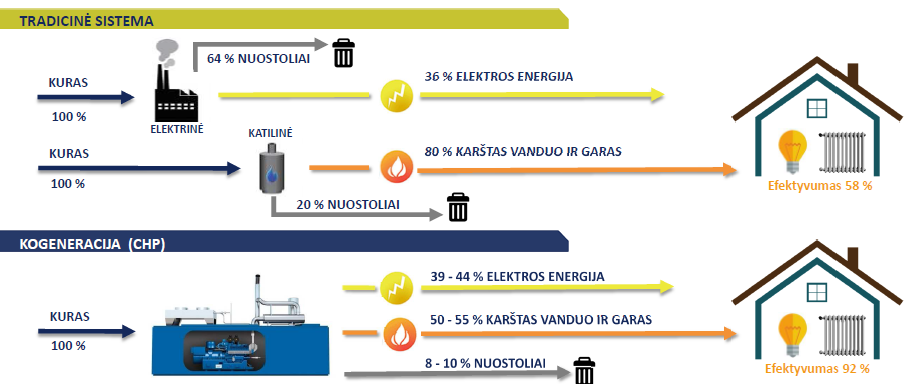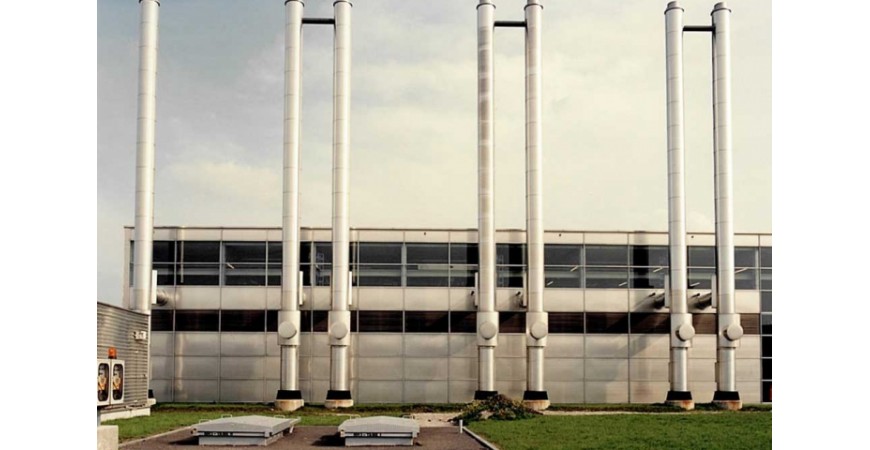Cogeneration is electricity and heat production at the same timeusing the excess heat after the production of electricity. This is one of the possibilities to reach a compromise between the growing needs for energy (energy production by conventional means burning the fuel) and striving for sustainable development.
Only one-third of fuel is mostly usefullyconsumed in conventional condensationpower-plants, while theefficiency of a small co-generation power plant can be as high as 90%(efficiency of electricity production + efficiency of heat production).

Efficiency of cogeneration power-plants increases for two main reasons
- The same primary energy (fuel) content is used not only for the production of electricity, but also for heat. That is, the excess heat is not used in conventional thermal power stations (it is“emitted”), while the heat produced bycogeneration power-plants is used for the production purposes and heating of facilities.
- With centralized power supply 5-10% of energy supply from high power thermal power stations is generated for the remote consumers, the reduction of its voltage in transformer substations and distribution losses. Cogeneration power-plants are built near the heat consumer, who is also a consumer of electricity, so the electricity needs to be distributed;as a result, thesupply losses are much lower. Cogeneration power-plants allow the production of required amount of energy using the fuel less by up to 40%.

Other advantages of cogeneration power-plants are as follows:
- Less environmental pollution with eliminated combustion products due to more efficient fuel consumption;
- Better possibility tolocal fuel- biomass, industrial, agricultural, domestic waste - is insmall power-plantsoperating in the districts of the country. The use of such a fuel meets the principles of sustainable development, it is less expensive than gas or oil fuel used in high-power plants;
- Efficient fuel consumption and the ability to use local fuel reduces the dependence of energy sector in the country on imported fuels;
- During the construction of low-power cogeneration plants workplaces, small and medium-sized business enterprises are create and the regions are developed –it is an effective way of dealing with social problems.
- The branch of alternative business!
The following cogeneration power-plants are distinguished according to the power and the use:
- High-power (> 50 MW) urban cogeneration power-plants, which generate electricity and heat. Heat is supplied to the users of large district heating systems.
- Medium power (from 1 MW to 50 MW) urban cogeneration plants, which generate electricity and supply the heat to local heating networks.
- Cogeneration power-plants of buildings, which generate electricity and supply it for the thermal needs of a building/group of buildings.
- Industrial cogeneration power-plants, which generate electricity and steam or hot technological water for the needs of the industry.
There are various technologies of cogeneration. One of them are old and well known, others are still only at innovation stage, and therefore are widely used. Stirling engines, microturbines, fuel cells and other technologies are still under the development and uncommon; therefore, they are quite expensive and are not offered to be introduced in Lithuania now. Currently, the most common in the world are steam turbines, gas turbines, combined cycle power-plants and internal combustion (piston) engines.
Steam turbines - is the oldest common cogeneration facility. Operation principle of steam turbine is based on the expansion of the steam inside the turbine. High-pressure superheated steam is generated inpower Boilers, which generates mechanical energy during the expansion inside the steam turbine, which is used to generate electricity in the generator. When small and low-pressure cogeneration gas turbines are used, only 7-20% of fuel energy is converted into electrical energy. Large part of energy is converted into the heat (steam). Steam turbines range from 500 kW to 500 MW. They are characterized by greatratio of generated heat and electric power and high relative investments, calculating 1 kW of electric power generation capacity.
Gas turbines - is the type of cogeneration facilities that has become the most popular in recent years. The operation principle of gas turbines is based on the expansion of compressed gas and air mixture combustion productsburning inside it. The turbine rotatesdue to the expansion of combustion products, and that results in mechanical energy. A large part of the mechanical energy is transferred to the air compressor to pressurize the air, where the compressor consumes up to 50% of the mechanical energy generated by the turbine. About 20% of primary energy is transformed into the electric energy and 65% is transformed into the heat. The efficiency of electric energy generation is up to 25-35% of the fuel heat used. Small gas turbines are less efficient, their efficiency is up to 20-30%;the efficiency of bigger turbines is similar to the internal combustion engines.
Combined cycle power - plants. This is a combination ofsteam and gas turbines, i.e., gas and steam turbines installed in series. Combustion products expanded inside the gas turbine are used for the generation ofhigh pressure steam. High pressure steam expands inside the steam turbine. Thus the efficiency ofelectric power generation up to 55% of the fuel calorific value is achieved. Usuallythe capacity of such facilities is over 10 MWe, and they are built within larger heat networks or industrial companies.
Internal combustion (mainly gas-fired piston) engines - is one of the most popular types of cogeneration facilities used for electricity and heat production in industrial companies, urban district heating systems, hospitals, shopping centres and other public buildings. “Otto” cycle and diesel engines are the two main types of internal combustion (piston) engines. Operating principle of diesel engines is self-ignition, pressing air and liquid fuel (fuel oil, natural gas-liquid) mixtures. Gas “Otto” cycle operating piston-type internal combustion enginesare usedmost commonly. The operating principle of these engines is as follows: the mixture of compressed air and fuel is ignited in the cylinder by a spark. Burning fuel and air mixture expands and pushes the pistons of cylinder. Thusthe energy is transformed into the piston movements. The engines are characterized by high efficiency of electric energy generation (up to 45% of burnt fuel energy value). The ratio of generated heat and electricity normally ranges from 0.5:1 to 2:1. Internal combustion engines are usually used for the cogeneration, in case ofthe needs of low energy and heat (for the production of steam and/or hot water). Internal combustion engines are standard products that are produced in series. The most popular arethe facilities with the capacity from 100 kW to 5 MW. Small facilities are less expensive compared to other cogenerations facilitiesof similar power.


